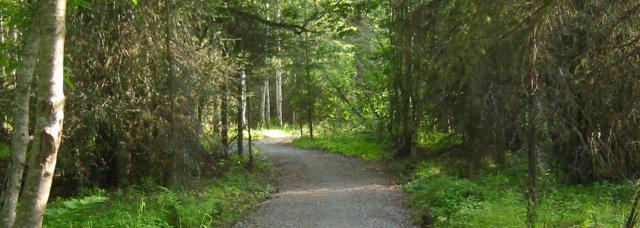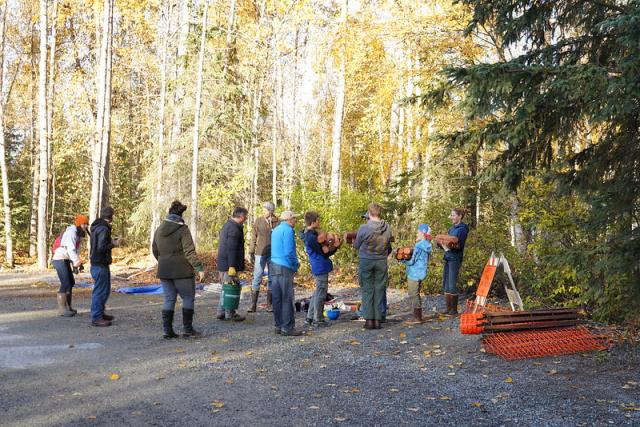Exploring the Campbell Tract Special Recreation Management Area: Flora, fauna, and volunteer opportunities
Nestled in the heart of Anchorage, visitors and locals alike can experience a hidden gem of natural beauty without ever leaving the city. The Campbell Tract Special Recreation Management Area is a 730-acre swath of land managed by the Bureau of Land Management in Alaska. Whether you're a wildlife enthusiast, a budding botanist, or someone looking to make a positive impact, Campbell Tract offers a wealth of experiences, including hiking, birdwatching, and volunteer opportunities that help preserve this incredible landscape for generations to come.
The Campbell Tract boasts a unique blend of wetlands, forests and meadows that make for a unique blend of ecosystems. As you explore the area, you're likely to encounter an array of plant and animal species that thrive in this part of the state. The plant life at Campbell Tract is both vibrant and varied. If you look up while walking along the 25-mile trail system, towering black spruce, white spruce and paper birch make the area feel even more remote. Along the trailside, vibrant shrubs such as blueberry and cranberry thrive. During the warmer months, the forest floor is often blanketed with mosses, ferns and colorful, native wildflowers like fireweed and alpine forget-me-nots. The wetlands are home to tall grasses and sedges, providing vital habitat for wildlife.

Wildlife is abundant at Campbell Tract, offering incredible opportunities for animal sightings. Mammals including moose, lynx, foxes, black bears and red squirrels roam the area, while smaller creatures like snowshoe hares and voles make their homes in the underbrush. The Campbell Tract should be of particular interest to birdwatchers in the city who will be treated to various species, including bald eagles, goshawks and various songbirds. In the wetlands, waterfowl like mallards and northern pintails, as well as migratory species such as sandhill cranes and swans, are often spotted floating or in flight.
All visitors are encouraged to remain bear aware while viewing wildlife on public lands. Following some basic ‘bear aware’ tips may help keep you and Alaska’s wildlife safe:
- Do not feed bears or other wildlife.
- Know Before You Go: When working or recreating in bear habitat- think about what you will do if you have a bear encounter before you go.
- Let someone know where you are going and when you plan to return.
- Read all signs at trailheads.
- Stay alert, do not wear headphones/ear buds and cautiously approach any blind corners on the trail.
- Carry bear spray that it is easily accessible. Know how to use it.
- Hike as a group, keep children with you and dogs leashed (or leave your dogs at home).
- Make plenty of noise.
- Never allow a bear to get your food or garbage when recreating or camping – don’t leave it unsecured. This also includes wrappers, bird feeders, dog food, compost, beehives and chicken coops at private residences. If a bear gets your food or garbage, it will likely come back.
- If you see a bear, maintain a safe distance and alter your route to avoid the bear. Never block a bear’s travel route.
- If you see a cub alone, don't approach. Mother bears are very defensive of their cubs.
- If you encounter a bear, stand your ground-back away slowly if the bear has stopped its approach or is unaware of you. Never run from a bear- it could result in the bear chasing you.
Additionally, while exploring the natural beauty of Campbell Tract, please keep in mind the rules surrounding the collection of natural and cultural items on public lands. As part of federal land managed by the BLM, the Campbell Tract is subject to specific regulations to protect the area's flora, fauna, cultural, and ecosystems and we rely on you to maintain its natural character. Generally, collecting items like plants, rocks, cultural items, or animals is prohibited on public lands unless specifically permitted. These regulations help preserve the natural beauty and ecological balance of the area, ensuring its continued access for future generations.

A lot of work has gone into Campbell Tract in recent years. There has been a focus on increased trail maintenance and an updated recreation plan for the area, as well as officially designating trails in the travel management plan. There has also been new trail construction and updated signs and maps implemented around Campbell Tract.
If you’re interested in experiencing the Campbell Tract in a more hands-on way, consider becoming a volunteer. BLM Alaska offers various opportunities for individuals to get involved and make a positive impact on the land. Volunteering is a great way to contribute to the upkeep of the area, whether you are maintaining trails, monitoring wildlife or assisting with educational programs. To find out about current or upcoming volunteer opportunities, reach out to the Anchorage Field Office at blm_ak_afo_general_delivery@blm.gov or visit volunteer.gov.
The Campbell Tract Special Recreation Management Area offers something for everyone, from nature lovers to volunteers. The lush forests, wetlands and diverse wildlife make it an incredible place to explore, while BLM’s policies help ensure its protection for years to come. By following guidelines on collecting natural items and participating in volunteer programs, you can contribute to the stewardship of this remarkable Alaskan landscape and grow your connection to the lands.
Azure Hall, Public Affairs Specialist
Related Stories
- BLM recreation sites available to all: Exploring accessibility on Arizona’s public lands
- Steer clear of muddy roads and trails this spring
- BLM Recreation Sites Available to All: Exploring Accessibility on Alaska’s Public Lands
- A boatload of recreational opportunities
- BLM Colorado, Grand Junction Field Office host recreation summit
